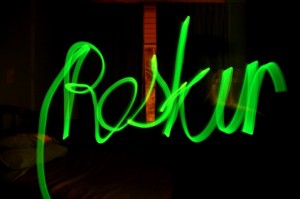The rapidly expanding field of wearable technologies fuses fashion and object design with portable, networked communication devices that respond to a range of environmental, biological and electronically mapped signals in unique ways.While portable media devices from the Walkman, boom box and iPod have long existed in the same stratosphere as the latest irresistible fashion item, what happens when these objects start to merge? A dress that can be scratched? Sound artist Somaya Langley finds just such a dress in her review of Alice Santaro’s Sonic Fabrics at ISEA 2006. Santaro’s work utilises woven audiotape fabrics from which sound fragments can be retrieved with a hand held Walkman play head.
This edition of Filter is dedicated to exploring wearables from a range of perspectives including media and bio art, craft and design, to the potential applications of research programs into nanotechnologies and technological textiles. While iPods, mobile phones, operating systems and other devices can be reskinned, shifting visual identity rapidly researcher and artist Stephen Barrass considers responsive tactile interfaces and our more fixed covering and primary sensory organ, the skin. He poses the question what might it be like to get a reFur?
Ionat Zurr and Oron Catts from SymbioticA discuss Bioware; the use of living biological processes within materials and garments. In the Victimless Leather project the ethics of using the skin of once living beings as protective second skin is circumscribed by the practice of growing leather like material from cell lines and biopsies.
The field of wearables brings dialogue about the materiality of objects, and the relationship between craft and technological practices to the surface. Kevin Murray traces the relationship between the purity of the iPod’s white acrylic surface and the craze for immaculate porcelain in the eighteenth century. In his article “A lapidary destiny” setting and stone are analogous to hard and software, the screen becomes the clasp or setting of the shifting light of media gems.
Jeweller and object designer Susan Cohn traces the evolution of jewellery practice and its changing relationship with technology from research tool to technology as strategy for conceptual motivation: jewellery moves from ornamental object to functional or smart object.Dr. Kristin Alford outlines the forthcoming Weaving with Light: Advanced Technology in Social Enterprise symposium to be held in Melbourne in April 2007. The symposium will focus on bringing social programs, technological textiles, portable and nanotechnologies, into synergistic relationships that may benefit remote, indigenous and disadvantaged communities. The potential for the field of wearables to offer portable and low cost solutions for communities on the other side of the technological divide in the area of portable light and water filtration is very positive.
This reSkin edition of Filter and its launch coincides with the Wear Now symposium at the National Museum of Australia. The symposium brings together artists, researchers, and scientists fresh from the reSkin lab to discuss wearable histories, the current state of practice, research and development and outcomes from the lab. Some of our writers and reviewers for this edition are drawn from the pool of talented people involved in both reSkin and Wear Now, including our national facilitators, symposium speakers lab participants. We have included as many images of the work of our facilitators and participants as the covers would hold. We have also included short profiles on each of the artists participating in reSkin. The participants include international artists from the US, UK and from around Australia. The artists are an exciting group many of whom are already working in the field of wearables, with diverse backgrounds in fashion design, performance, installation, interaction design, media art, jewellery and object design, architectural design and computer science.
I hope that you are able to join us for Wear Now and that through this special edition of Filter you are able to share in some of the dialogue and works surrounding reSkin.
Alexandra Gillespie
Alexandra has worked as an artist, project manager and university educator in the field of media arts since 1999. Her work is exhibited nationally and internationally and is concerned with integrating diverse media forms into spatial and responsive environments. She is project manager on the reSkin wearable technologies laboratory and a PhD candidate at The Australian National University, School of Art.
Read More
Watch More
 This work is licensed under a Creative Commons Attribution-NonCommercial-ShareAlike 2.5 Australia.
This work is licensed under a Creative Commons Attribution-NonCommercial-ShareAlike 2.5 Australia.







